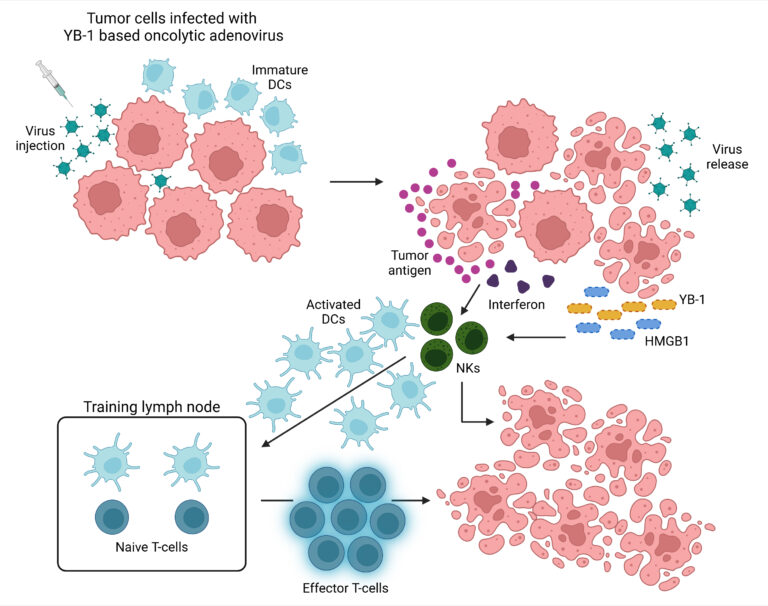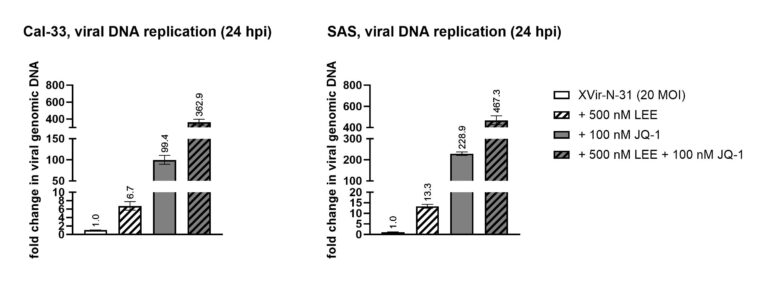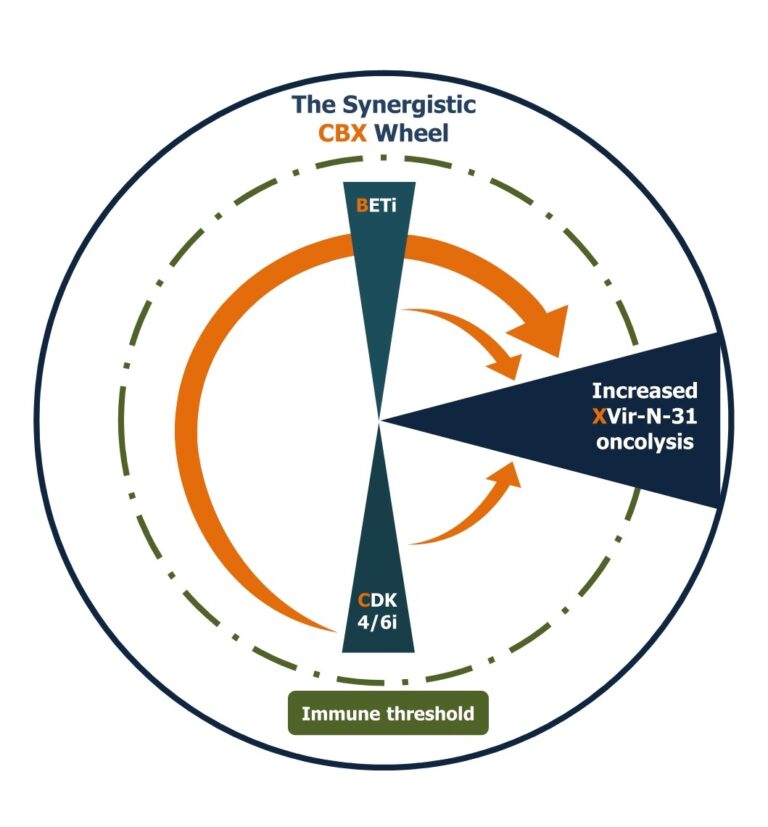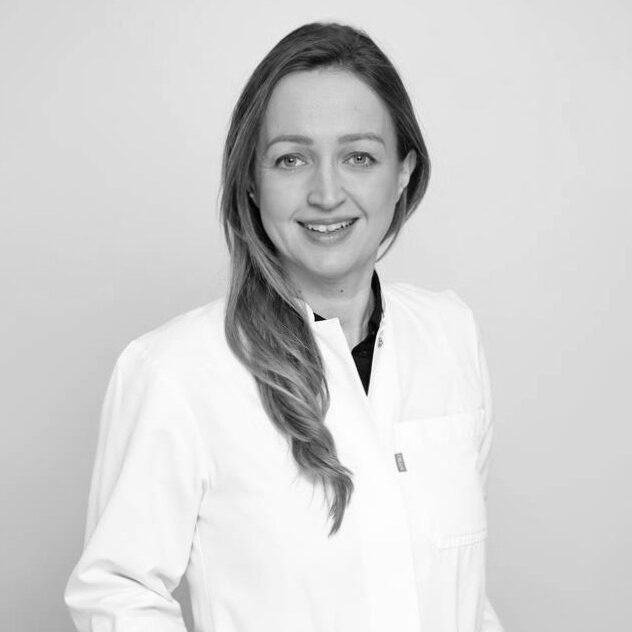
Anichstraße 35
6020 Innsbruck
Email: Carolin.Goetz@i-med.ac.at
Website: https://www.i-med.ac.at/mund-kiefer-gesichts-chirurgie/
Research year
Research Branch (ÖSTAT Classification)
301904, 302010, 302092, 302033, 304007, 302047, 302056, 302062, 302037
Keywords
cancer treatment, cell cycle intervention and epigenetics, cleft surgery, microsurgery, Oncolytic Virotherapy, oral cancer, quality of life, and Reconstructive Surgery
Research Focus
Clinical Research
Our department’s research is focused on the essential topics in oral and maxillofacial surgery. Retrospective and prospective studies are based on prevention, therapy, outcome and the patients’ quality of life. The main research areas are oral cancer and reconstructive surgery, cleft surgery and medication necrosis of the jaws.
Carolin Götz, Lena Denk, Philipp Ehrmann, Elisabeth Maier, Dominik, Scheibl
Molecular Research
The molecular research focus is the development of an oncolytic virotherapy combined with cell cycle, bromodomain and extra-terminal domain protein (BET) inhibitors.
Per Sonne Holm, Felicia Segeth, Toni Rabensteiner., Shasta Pelzer
General Facts
In 2020, the molecular research unit of the University Hospital of Oral and Maxillofacial Surgery established its laboratories. They focused on oncolytic virotherapy and molecular analyses. The laboratories comprise S1 and S2. This means that the research group can perform all necessary steps for their analyses autonomously. These include virus production, cell culture practice, infection and multiple molecular biological methods. Investigations of this oncolytic virotherapy and its underlying mechanisms are supported by collaborations with other national and international research groups.
Research
The molecular research unit is investigating a combination therapy using an oncolytic adenovirus, XVir-N-31, and distinct cancer therapeutics. Cell culture and molecular analyses are conducted to prove the effectiveness of the therapy and evaluate the molecular background.
The entry of oncolytic viruses (OVs) into tumour therapy has caused a major shift in current and future treatment regimens. Oncolytic virotherapy uses (modified) viruses that selectively replicate in and kill cancer cells. Despite this novel approach to fighting cancer, clinical studies have shown that Ovs replicate less in cancer cells, limiting their effectiveness as a monotherapy. However, the good combination of OVs with other anti-cancer interventions has the capacity to counteract this drawback without increasing toxicity. The development of effective combination therapies is therefore pivotal to the future success of OVs in clinical treatment regimens.
It was also discovered that the overall antitumour activity of OVs depends on more than just the direct killing of cancer cells, but also on initiating a systemic immune response (Fig. 1).
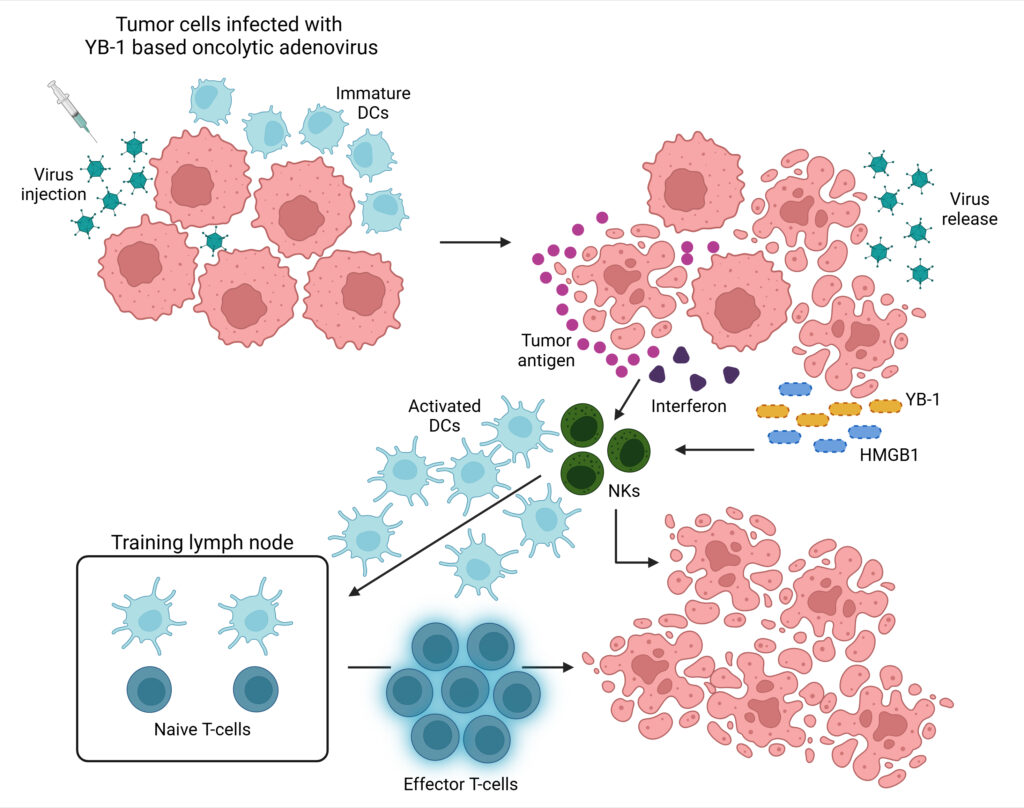
A combination approach with existing immune therapies, e.g. immune checkpoint inhibitors or cell cycle inhibitors, is therefore very promising.
CDK4/6 inhibitors have shown to increase the antitumour activity of OV XVir-N-31 by enhancing immune responses (Schober et al. 2023). CDK4/6 inhibitors are effective in stopping cancer cells from growing. They do this by arresting the cell cycle. Both mechanism of CDK4/6 inhibitors are beneficial for virotherapy. Hence, CDK4/6 inhibitors are a key focus of our cancer therapeutics research. We have demonstrated that CDK4/6 inhibitor Ribociclib (LEE) enhances viral DNA replication of XVir-N-31 in head and neck cancer cells (Fig. 2).
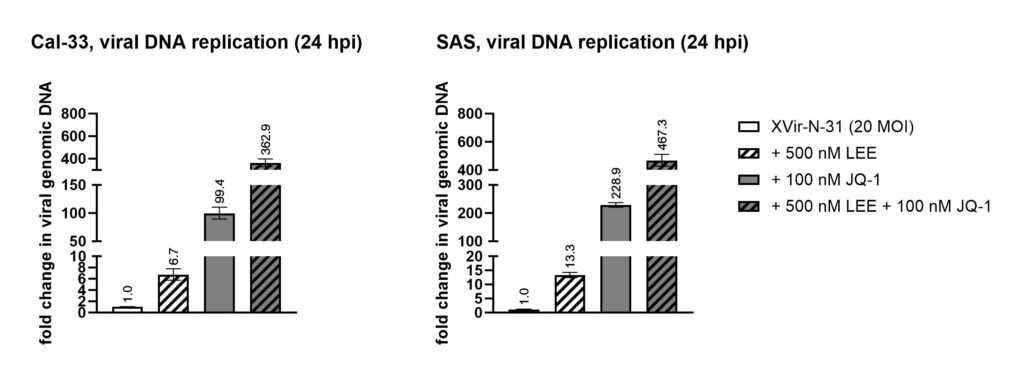
The research unit also analysed a second class of inhibitors: bromodomain and extra-terminal domain protein (BET) inhibitors. These inhibitors interfere with gene transcription and prevent the expression of oncogenes, such as MYC. They also induce epigenetic changes in the cell. We have also shown that BET inhibitor JQ-1 increases viral DNA replication of XVir-N-31 in head and neck cancer cells (Fig. 2).
The Molecular Research Unit of the University Hospital for Cranio-maxillofacial and Oral Surgery is currently researching a triple therapy using oncolytic adenovirus XVir-N-31, a CDK4/6 inhibitor, and a BET inhibitor. Both inhibitors alone increase viral DNA replication of XVir-N-31, but their combination exceeds the individual applications (Fig. 2). The combination of CDK4/6 inhibition and BET inhibition acts synergistically on XVir-N-31, possibly leading to a sufficient antitumour (immune) response (Fig. 3).
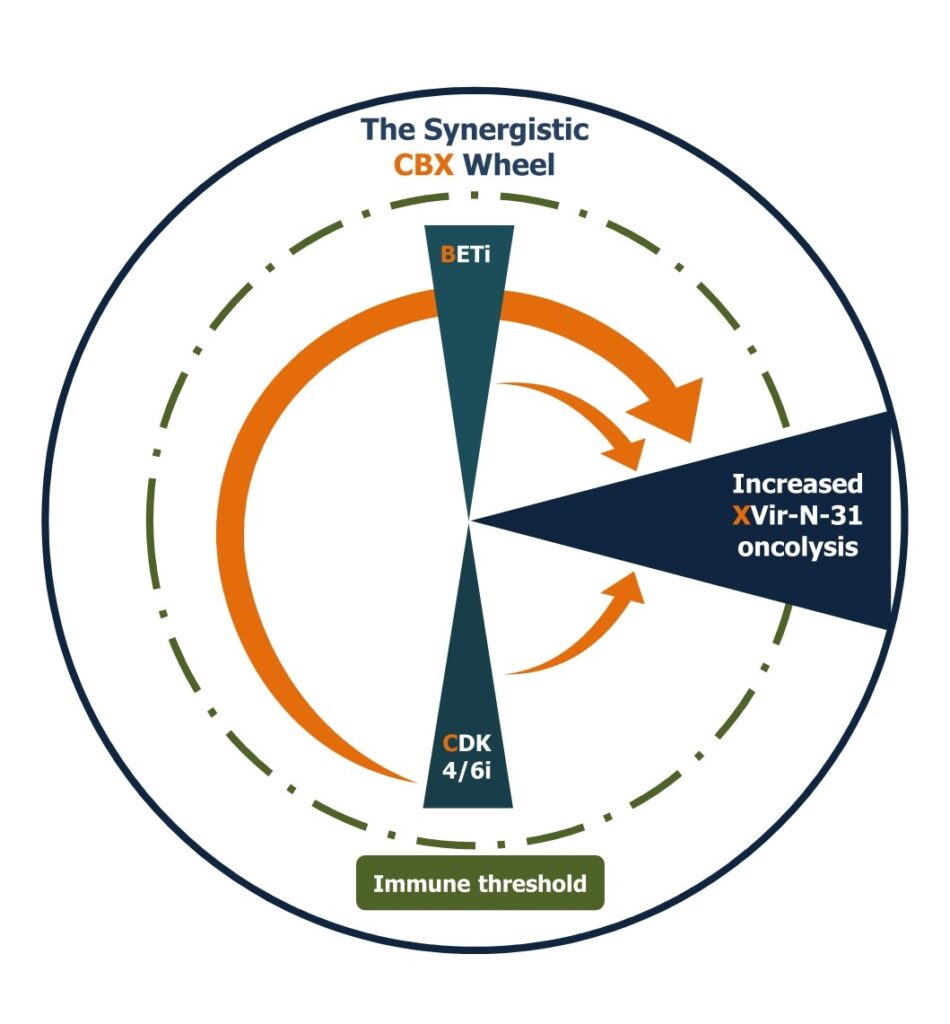
We are currently analysing the detailed characterisation of the translational and molecular aspects of this triple therapy. Our focus is on transcriptional regulation and epigenetic modifications.
Pictures
Selected Publications
Yuchen Bai, Carolin Gotz, Ginevra Chincarini, Zixuan Zhao, Clare Slaney, Jarryd Boath, Luc Furic, Christopher Angel, Stephen M Jane, Wayne A Phillips, Steven A Stacker, Camile S Farah, Charbel Darido. YBX1 integration of oncogenic PI3K/mTOR signalling regulates the fitness of malignant epithelial cells. Nat Commun 2023 Mar 22;14(1):1591.doi: 10.1038/s41467-023-37161-0
The Value of Surveillance Imaging of Oral Squamous Cell Carcinoma.Bissinger O, Von den Hoff A, Maier E, Obermeier KT, Stimmer H, Kolk A, Wolff KD, Götz C.Cancers (Basel). 2024 Jan 1;16(1):207. doi: 10.3390/cancers16010207.PMID: 38201635.
Targeting Cell Cycle Facilitates E1A-Independent Adenoviral Replication. Ehrenfeld M, Segeth F, Mantwill K, Brockhaus C, Zhao Y, Ploner C, Kolk A, Gschwend JE, Nawroth R, Holm PS. J Virol. 2023: e0037023. doi: 10.1128/jvi.00370-23
The Oncolytic Adenovirus XVir-N-31 Joins Forces with CDK4/6 Inhibition Augmenting Innate and Adaptive Antitumor Immunity in Ewing Sarcoma. Schober SJ, Schoening C, Eck J, Middendorf C, Lutsch J, Knoch P, von Ofen AJ, Gassmann H, Thiede M, Hauer J, Kolk A, Mantwill K, Gschwend JE, Burdach SEG, Nawroth R, Thiel U, Holm PS. Clin Cancer Res. 2023;29(10):1996-2011. doi: 10.1158/1078-0432.CCR-22-1961..
TCR-transgenic T cells and YB-1-based oncolytic virotherapy improve survival in a preclinical Ewing sarcoma xenograft mouse model. Schober SJ, Thiede M, Gassmann H, von Ofen AJ, Knoch P, Eck J, Prexler C, Kordass-Wally C, Hauer J, Burdach S, Holm PS, Thiel U. Front Immunol. 2024 Jan 22;15:1330868. doi: 10.3389/fimmu.2024.1330868.
Do Surgical Intervention Type and Baseline Condylar Position Affect Spatial Dimension Changes of the Temporomandibular Joint in the Surgical Correction of Skeletal Class II Deformities? J Oral Maxillofac Surg. 2024 Aug. 2024 Aug;82(8):931-943. doi: 10.1016/j.joms.2024.04.016.Epub 2024 Apr 26. Linus Christian Hupp 1, Michael Verius 2, Andreas Kolk 3, Rüdiger Emshoff 4
Factors associated with voice-related quality of life among patients with temporomandibular disorders J Appl Oral Sci. 2024. J Appl Oral Sci. 2024 Mar 25:32:e20230296. doi: 10.1590/1678-7757-2023-0296.eCollection 2024. Rüdiger Emshoff 1, Magdalena Astl 2, Aris Ioannis Giotakis 3, Linus Christian Hupp 1, Andreas Kolk
Perioperative anticoagulation in head and neck free flap reconstructions: Experience of an anticoagulative scheme and its modification. Microsurgery . 2024 Jan;44(1):e31096. doi: 10.1002/micr.31096.Epub 2023 Aug 21. Florian D Grill 1, Lisa Pilstl 1, Lucas M Ritschl 1, Achim von Bomhard 1 2, Herbert Stimmer 3, Andreas Kolk 4, Denys J Loeffelbein 1 5, Klaus-Dietrich Wolff 1, Thomas Mücke 1, Andreas M Fichter 1
Rhinoresistometry as a Cost-Efficient and Time-Saving Alternative to Acoustic Rhinometry for Longitudinal Assessment of Nasal Patency in Orthognathic Surgery. 2024 Mar-Apr;35(2):437-441. doi: 10.1097/SCS.0000000000009931.Epub 2024 Jan 22. J Craniofac Surg. 2024 Mar-Apr. Aris I Giotakis 1, Michael Verius 2, Teresa B Steinbichler 1, Annette Runge 1, Andreas Kolk 3, Linus C Hupp 3
Minimally invasive balloon-assisted sinus floor elevation vs. conventional transcrestal procedure in terms of new bone formation in a split-mouth Goettingen minipig model Andreas Kolk et al. Int J Implant Dent. 2024. 2024 Dec 18;10(1):63.doi: 10.1186/s40729-024-00546-x. Andreas Kolk 1 2, Florian Bauer 3, Jochen Weitz 3, Robert Stigler 4, Benjamin Walch 4, Florian Grill 3,
The Effect of Advanced Platelet-Rich Fibrin Plus (A-PRF+) on Graft Stability in Dental Implants and Alveolar Ridge Augmentation Procedures: A New Low-Speed Standardized Centrifugation Protocol. Dent J (Basel). 2024 Oct 31;12(11):349.doi: 10.3390/dj12110349. Benjamin Walch 1, Andreas Kolk 1, Dominik Scheibl 1, Maria Guarda 1, Sarah Christine Maier 2, Lena Denk 1
Cleansing efficacy of an oral irrigator with microburst technology in adolescent orthodontic patients. A randomized-controlled crossover study Clin Oral Investig. 2024 Sep 13;28(10):524. doi: 10.1007/s00784-024-05842-9. Hanna Gänzer 1, Manuel Kasslatter 2, Vera Wiesmüller 3, Lena Denk 3, Anna-Maria Sigwart 3, Adriano Crismani 4
How does medication-related osteonecrosis of the jaw (MRONJ) influence the health-related quality of life after surgery?. BMC Oral Health. 2025 Jun 21;25(1):951.doi: 10.1186/s12903-025-06171-3. Bissinger O, Greiser J, Maier E, Ehrmann P, Kakoschke T, Wolff KD, Götz C.
Morbidity of the free fibular flap in reconstructive surgery.Head Neck 2025 Jan 22.doi: 10.1002/hed.28064. Götz C, Dietz F, Bissinger O, Wolff KD, Ehrmann P, Weitz J.
Minimally invasive myo-osseous chimeric DCIA-Flap without crest, spine and skin to reconstruct composite defects of the mandible using virtual surgical planning and CAD/CAM technology. Eur J Med Res.2025 Feb 12;30(1):91. doi: 10.1186/s40001-024-02233-4 Bissinger O, Maier, E, Ehrmann P, Walch B, Götz C, Poxleitner P, Posta P.
Association Between Treatment Modality of Pediatric Subcondylar Fractures and Functional Outcomes at 6-Month Follow-Up: A Retrospectice Pilot Study.Cureus 2024 Dec 22;16(12):e76226.doi: 10.7759/cureus.76226. eCollection 2024 Dec. Scheibl D, Walch B, Verius M, Götz C, Emshoff R.
Selection of Funding
Fördergeber: FWF-Internationale Förderung (Deutschland DFG)
Projekttitel: YB-1 based virotherapy
Laufzeit: 01-10-2025-31-09-2028
Projektvolumen: 257.041,05 €
Collaborations
Laboratory of Molecular Neuro-Oncology, Department of General Neurology, Hertie Institute for Clinical Brain Research, University of Tübingen, Tübingen, Germany
Department of Proteomics and Signal Transduction, Max Planck Institute of Biochemistry, Martinsried, Germany
Department of Urology, Klinikum rechts der Isar, Technical University of Munich, Munich, Germany
Department of Microbiology, Immunology, and Oncology, Western University, London, Canada.
